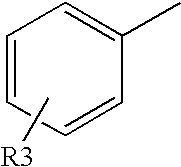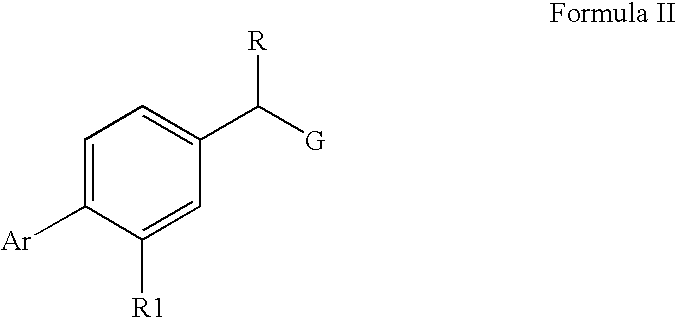Pharmaceutical Composition And Methods For Treating Neurodegenerative Disorders
a technology for neurodegenerative disorders and pharmaceutical compositions, applied in the field of pharmaceutical compositions and methods, can solve the problems of brain disorders that seriously affect the ability of people to carry out normal daily activities, no cure, and unknown, and achieve the effects of reducing, slowing or preventing an increase in a42 protein levels, reducing, and reducing amyloid 42 protein levels
- Summary
- Abstract
- Description
- Claims
- Application Information
AI Technical Summary
Benefits of technology
Problems solved by technology
Method used
Image
Examples
example 1
Co-Formulation of R-flurbiprofen with SSRIs
[0089]
R-Flurbiprofen Fluoxetine TabletsIngredientAmountR-Flurbiprofen400mgMicrocrystalline Cellulose392mgColloidal Silicon Dioxide4mgMagnesium Stearate4mgFluoxetine40mg
[0090]
R-Flurbiprofen Fluvoxamine TabletsIngredientAmountR-Flurbiprofen400mgMicrocrystalline Cellulose392mgColloidal Silicon Dioxide4mgMagnesium Stearate4mgFluvoxamine100mg
[0091]
R-Flurbiprofen Paroxetine TabletsIngredientAmountR-Flurbiprofen400mgMicrocrystalline Cellulose392mgColloidal Silicon Dioxide4mgMagnesium Stearate4mgParoxetine40mg
[0092]
R-Flurbiprofen Sertraline TabletsIngredientAmountR-Flurbiprofen400mgMicrocrystalline Cellulose392mgColloidal Silicon Dioxide4mgMagnesium Stearate4mgSertraline100mg
[0093]
R-Flurbiprofen Citalopram TabletsIngredientAmountR-Flurbiprofen400mgMicrocrystalline Cellulose392mgColloidal Silicon Dioxide4mgMagnesium Stearate4mgCitalopram30mg
[0094]
R-Flurbiprofen Escitalopram Oxalate TabletsIngredientAmountR-Flurbiprofen400mgMicrocrystalline Cellulos...
example 2
Clinical Investigation of the Combination of R-flurbiprofen and a SSRI for Alzheimer's Disease
[0096] According to this example, R-flurbiprofen in combination with an SSRI is examined for its actions in healthy subjects as well as subjects with mild to moderate
[0097] Alzheimer's disease (AD). Evaluation of a R-flurbiprofen and an SSRI for treating Alzheimer's is accomplished in a three-group parallel design; each group having 53 subjects for a total of 159 subjects. Subjects are treated with R-flurbiprofen and a SSRI (e.g., sertraline) or a matching placebo twice a day for forty-eight weeks.
[0098] Test AD subjects are selected based on the following criteria: Subjects (1) have a diagnosis of dementia according to the DSM IV (TR) and meets the NINCDS-ADRDA (McKhann et al. Neurology 34:939-944 (1984)) criteria for probable Alzheimer's disease, (2) have CT or MRI since onset of memory impairment demonstrating absence of clinically significant focal adhesion, (3) have MMSE (Mohs et al...
example 3
Treatment of Alzheimer's Disease with R-Flurbiprofen-SSRI Combination
[0111] R-flurbiprofen can be administered twice daily as tablets containing 400 mg of active ingredient or as a capsule containing 400 mg of the active ingredient. A higher dose can be administered to the patient in need of such treatment which can involve the patient taking e.g., a 800 mg dose of R-flurbiprofen in the morning and a 800 mg dose of R-flurbiprofen in the evening. Typically, for the treatment of mild-to-moderate Alzheimer's disease, an individual is diagnosed by a doctor as having the disease using a suitable combination of observations. One criterion indicating a likelihood of mild-to-moderate Alzheimer's disease is a score of about 15 to about 26 on the MMSE test. Another criteria indicating mild-to-moderate Alzheimer's disease is a decline in cognitive function. R-flurbiprofen can also be administered in liquid or dosage forms. The dosages can also be divided or modified, and taken with or without...
PUM
| Property | Measurement | Unit |
|---|---|---|
| concentration | aaaaa | aaaaa |
| concentration | aaaaa | aaaaa |
| concentration | aaaaa | aaaaa |
Abstract
Description
Claims
Application Information
 Login to View More
Login to View More - R&D
- Intellectual Property
- Life Sciences
- Materials
- Tech Scout
- Unparalleled Data Quality
- Higher Quality Content
- 60% Fewer Hallucinations
Browse by: Latest US Patents, China's latest patents, Technical Efficacy Thesaurus, Application Domain, Technology Topic, Popular Technical Reports.
© 2025 PatSnap. All rights reserved.Legal|Privacy policy|Modern Slavery Act Transparency Statement|Sitemap|About US| Contact US: help@patsnap.com



